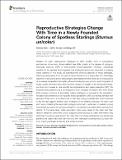Files in this item
Reproductive strategies change with time in a newly founded colony of spotless starlings (Sturnus unicolor)
Item metadata
| dc.contributor.author | Celis, P. | |
| dc.contributor.author | Graves, J.A. | |
| dc.contributor.author | Gil, D. | |
| dc.date.accessioned | 2021-06-16T15:30:11Z | |
| dc.date.available | 2021-06-16T15:30:11Z | |
| dc.date.issued | 2021-05-07 | |
| dc.identifier | 274637405 | |
| dc.identifier | 2e7e634b-3d0a-486a-a0ed-f6c8fb215244 | |
| dc.identifier | 000652337500001 | |
| dc.identifier | 85106193046 | |
| dc.identifier.citation | Celis , P , Graves , J A & Gil , D 2021 , ' Reproductive strategies change with time in a newly founded colony of spotless starlings ( Sturnus unicolor ) ' , Frontiers in Ecology and Evolution , vol. 9 , 658729 . https://doi.org/10.3389/fevo.2021.658729 | en |
| dc.identifier.issn | 2296-701X | |
| dc.identifier.other | RIS: urn:DDDBD444B4F2B65C51042F22F7C5DD1E | |
| dc.identifier.uri | https://hdl.handle.net/10023/23372 | |
| dc.description | Finance for fieldwork and labwork was provided by a grant to DG from the Spanish Ministry of Science (BOS2002-00105), and DG was recipient of another grant from the same source while writing this study (CGL2017-83843-C2-1-P). PC was funded by a Ph.D. grant from CONACYT (México). | en |
| dc.description.abstract | Variation in avian reproductive strategies is often studied from a comparative perspective, since even closely-related taxa differ greatly in the degree of polygyny, extra-pair paternity (EPP) or intra-specific brood-parasitism. However, substantial variation at the species level suggests that ecological factors are important in shaping these patterns. In this study, we examined the temporal plasticity of these strategies, following a population from the year of colony formation to 2 years after this. Parentage data from these years shows that polygyny decreased with time, likely as a consequence of increased competition for nesting sites and mates by new recruits, and immigrants of higher quality arriving to the colony as time passed. In parallel to this temporal change, we found an increase in intra-specific brood-parasitism and quasi-parasitism (QP). We interpret these patterns as a consequence of an increase of floaters with time; these birds pursue a mixture of alternative mating strategies to succeed in the population. We also found evidence of conspecific brood parasitism (CBP), by nesting females that laid part of the clutch in another nest or that after losing a partially laid clutch resorted to lay the last eggs in another nest. Analyses of the distance between the main nest and nests containing the secondary polygynous brood or extra-pair or parasitic young showed an avoidance of contiguous nests for conducting these alternative reproductive tactics. At the same time, these secondary nests were closer to the main nest than random distances within the colony, suggesting that access to public information was restricted to a narrow area around the main nest. Our study emphasizes how behavioral patterns are plastic traits that vary not only with individual circumstances, but also with time, tracking changes in density and social structure. | |
| dc.format.extent | 13 | |
| dc.format.extent | 603473 | |
| dc.language.iso | eng | |
| dc.relation.ispartof | Frontiers in Ecology and Evolution | en |
| dc.subject | Alternative reproductive strategies | en |
| dc.subject | Birds | en |
| dc.subject | Density | en |
| dc.subject | Extra-pair paternity | en |
| dc.subject | Floaters | en |
| dc.subject | Intraspecific brood parasitism | en |
| dc.subject | Quasi-parasitism | en |
| dc.subject | Sturnus unicolor | en |
| dc.subject | QH301 Biology | en |
| dc.subject | QL Zoology | en |
| dc.subject | NDAS | en |
| dc.subject.lcc | QH301 | en |
| dc.subject.lcc | QL | en |
| dc.title | Reproductive strategies change with time in a newly founded colony of spotless starlings (Sturnus unicolor) | en |
| dc.type | Journal article | en |
| dc.contributor.institution | University of St Andrews. School of Biology | en |
| dc.identifier.doi | https://doi.org/10.3389/fevo.2021.658729 | |
| dc.description.status | Peer reviewed | en |
This item appears in the following Collection(s)
Items in the St Andrews Research Repository are protected by copyright, with all rights reserved, unless otherwise indicated.

